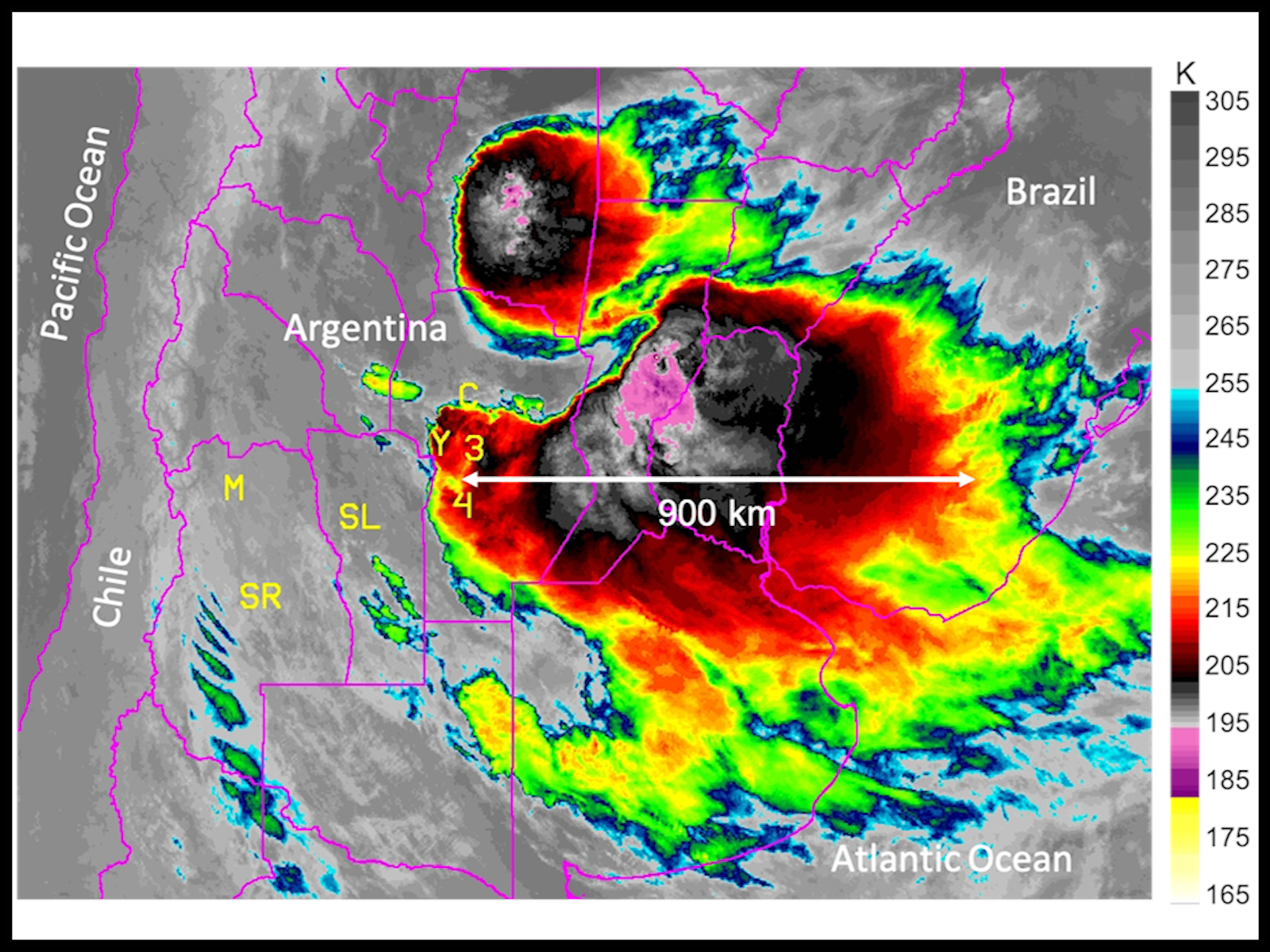New Techniques Highlight Model-Predicted Storm Growth Successes and Failures
Simulations accurately predicted storm cloud shield timing and growth, but not rain intensities, for over 300 tracked storm complexes

A large storm complex as observed by the GOES-16 satellite longwave infrared channel, which approximates cloud top temperature.
(Image by Adam Varble | Pacific Northwest National Laboratory)
The Science
Accurately predicting storms in weather and climate forecasts depends on having realistic representations of the atmospheric processes that grow clouds into large, high-impact storms. However, limited model evaluation adds uncertainty to forecasts of storm growth around the world. This study uses new datasets from a storm-generating hotspot in Argentina to show that a regional, storm-resolving model reproduces the growth rate and duration of storm clouds but fails to predict storm rain intensities. It further shows that heat and moisture transport into the storm are dominant controls on storm growth rate and duration.
The Impact
Large storm complexes produce severe weather and, as a critical component of the global energy, moisture, and aerosol cycles, impact the climate. This makes it important to evaluate how well models predict the storm growth processes that produce these large, impactful complexes. This study shows that a storm-resolving model reproduces storm cloud growth statistics, indicating promise for predicting such systems in storm-resolving weather and climate models. However, the model produces storm rainfall biases, likely due to insufficient model resolution and cloud physics representations, which will require improvement for such models to be used to predict high impact rainfall events.
Summary
Researchers performed a 6.5-month storm-resolving atmospheric model simulation, corresponding to the National Science Foundation-funded Remote sensing of Electrification, Lightning, And Mesoscale/microscale Processes with Adaptive Ground Observations (RELAMPAGO) and Department of Energy (DOE) Atmospheric Radiation Measurement program (ARM)-funded Cloud, Aerosol, and Complex Terrain Interactions (CACTI) field campaigns, covering an 1800 by 1500 km domain over Argentina to evaluate the ability of regional weather and climate models to predict the growth of storm complexes. They identified and tracked 363 observed and 343 simulated storm complexes using cloud top infrared brightness temperature (approximating cloud top temperature) and surface precipitation.
The simulation produced realistic storm numbers, lifetimes, diurnal cycles, and other cloud properties, including cloud shield size and growth rate. However, the model produced smaller rainfall areas, a greater proportion of heavy rainfall, and faster storm propagation, resulting from both model and retrieval bias contributions. The simulated rainfall biases increased as storms reached larger maximum sizes, greater maximum depths, longer growth periods, and faster growth rates. Growth sustenance controlled maximum storm size more than growth rate, with both controlled more by environmental low-level heat and moisture transport than other factors.
PNNL Contact
Adam Varble, Pacific Northwest National Laboratory, adam.varble@pnnl.gov
Funding
The study was funded by NSF project 1661662. Other support was provided by the DOE Office of Science Biological and Environmental Research as part of the ASR program. Pacific Northwest National Laboratory is operated by Battelle for the DOE under Contract DE-AC05-76RLO1830. Computing and disk storage resources were provided by the NCAR Computational and Information Systems Laboratory and the University of Utah Center for High Performance Computing . Some data analysis was also performed using computational resources provided by the National Energy Research Scientific Computing Center (NERSC), a DOE Office of Science User Facility supported by the Office of Science of the DOE under contract DE-AC02-05CH11231.
Published: October 22, 2021
Z. Zhang, A. Varble, Z. Feng, J. Hardin, E. Zipser, “Growth of Mesoscale Convective Systems in Observations and a Seasonal Convection-Permitting Simulation over Argentina.” Mon. Wea. Rev., 149(10), 3469–3490, (2021). [DOI: 10.1175/MWR-D-20-0411.1]